Social and Economic Changes: Impact of Living Standards on Environment
VerifiedAdded on 2023/06/11
|7
|2308
|128
Essay
AI Summary
This essay examines the complex relationship between rising living standards and their environmental consequences, focusing on social changes like increased private car ownership and economic shifts such as the growth in the tourism industry. It analyzes the debate surrounding these trends, with some arguing that they lead to increased pollution, deforestation, and wildlife destruction, while others suggest that families are adopting fuel-efficient vehicles and governments are implementing stricter environmental regulations to mitigate negative impacts. The essay explores evidence from various countries, including Australia, the UK, China, Brazil and Malaysia, highlighting both the detrimental effects of increased emissions and deforestation and the potential benefits of compact cars and environmental protection laws. It concludes that while improved living standards can drive social and economic changes that harm the environment, proactive measures by governments and individuals are crucial for promoting sustainable practices and minimizing ecological damage. Desklib provides access to similar essays and study tools for students.
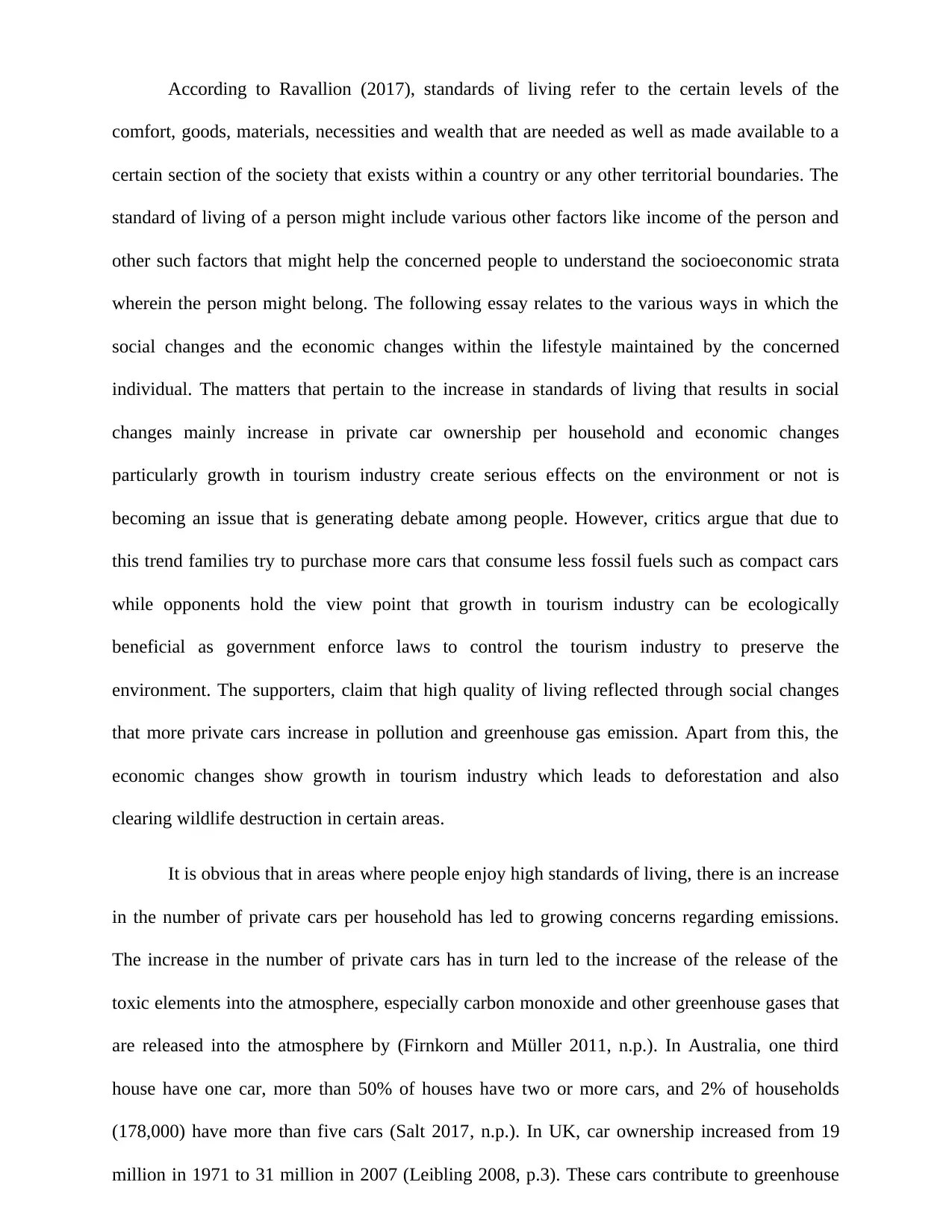
According to Ravallion (2017), standards of living refer to the certain levels of the
comfort, goods, materials, necessities and wealth that are needed as well as made available to a
certain section of the society that exists within a country or any other territorial boundaries. The
standard of living of a person might include various other factors like income of the person and
other such factors that might help the concerned people to understand the socioeconomic strata
wherein the person might belong. The following essay relates to the various ways in which the
social changes and the economic changes within the lifestyle maintained by the concerned
individual. The matters that pertain to the increase in standards of living that results in social
changes mainly increase in private car ownership per household and economic changes
particularly growth in tourism industry create serious effects on the environment or not is
becoming an issue that is generating debate among people. However, critics argue that due to
this trend families try to purchase more cars that consume less fossil fuels such as compact cars
while opponents hold the view point that growth in tourism industry can be ecologically
beneficial as government enforce laws to control the tourism industry to preserve the
environment. The supporters, claim that high quality of living reflected through social changes
that more private cars increase in pollution and greenhouse gas emission. Apart from this, the
economic changes show growth in tourism industry which leads to deforestation and also
clearing wildlife destruction in certain areas.
It is obvious that in areas where people enjoy high standards of living, there is an increase
in the number of private cars per household has led to growing concerns regarding emissions.
The increase in the number of private cars has in turn led to the increase of the release of the
toxic elements into the atmosphere, especially carbon monoxide and other greenhouse gases that
are released into the atmosphere by (Firnkorn and Müller 2011, n.p.). In Australia, one third
house have one car, more than 50% of houses have two or more cars, and 2% of households
(178,000) have more than five cars (Salt 2017, n.p.). In UK, car ownership increased from 19
million in 1971 to 31 million in 2007 (Leibling 2008, p.3). These cars contribute to greenhouse
comfort, goods, materials, necessities and wealth that are needed as well as made available to a
certain section of the society that exists within a country or any other territorial boundaries. The
standard of living of a person might include various other factors like income of the person and
other such factors that might help the concerned people to understand the socioeconomic strata
wherein the person might belong. The following essay relates to the various ways in which the
social changes and the economic changes within the lifestyle maintained by the concerned
individual. The matters that pertain to the increase in standards of living that results in social
changes mainly increase in private car ownership per household and economic changes
particularly growth in tourism industry create serious effects on the environment or not is
becoming an issue that is generating debate among people. However, critics argue that due to
this trend families try to purchase more cars that consume less fossil fuels such as compact cars
while opponents hold the view point that growth in tourism industry can be ecologically
beneficial as government enforce laws to control the tourism industry to preserve the
environment. The supporters, claim that high quality of living reflected through social changes
that more private cars increase in pollution and greenhouse gas emission. Apart from this, the
economic changes show growth in tourism industry which leads to deforestation and also
clearing wildlife destruction in certain areas.
It is obvious that in areas where people enjoy high standards of living, there is an increase
in the number of private cars per household has led to growing concerns regarding emissions.
The increase in the number of private cars has in turn led to the increase of the release of the
toxic elements into the atmosphere, especially carbon monoxide and other greenhouse gases that
are released into the atmosphere by (Firnkorn and Müller 2011, n.p.). In Australia, one third
house have one car, more than 50% of houses have two or more cars, and 2% of households
(178,000) have more than five cars (Salt 2017, n.p.). In UK, car ownership increased from 19
million in 1971 to 31 million in 2007 (Leibling 2008, p.3). These cars contribute to greenhouse
Paraphrase This Document
Need a fresh take? Get an instant paraphrase of this document with our AI Paraphraser
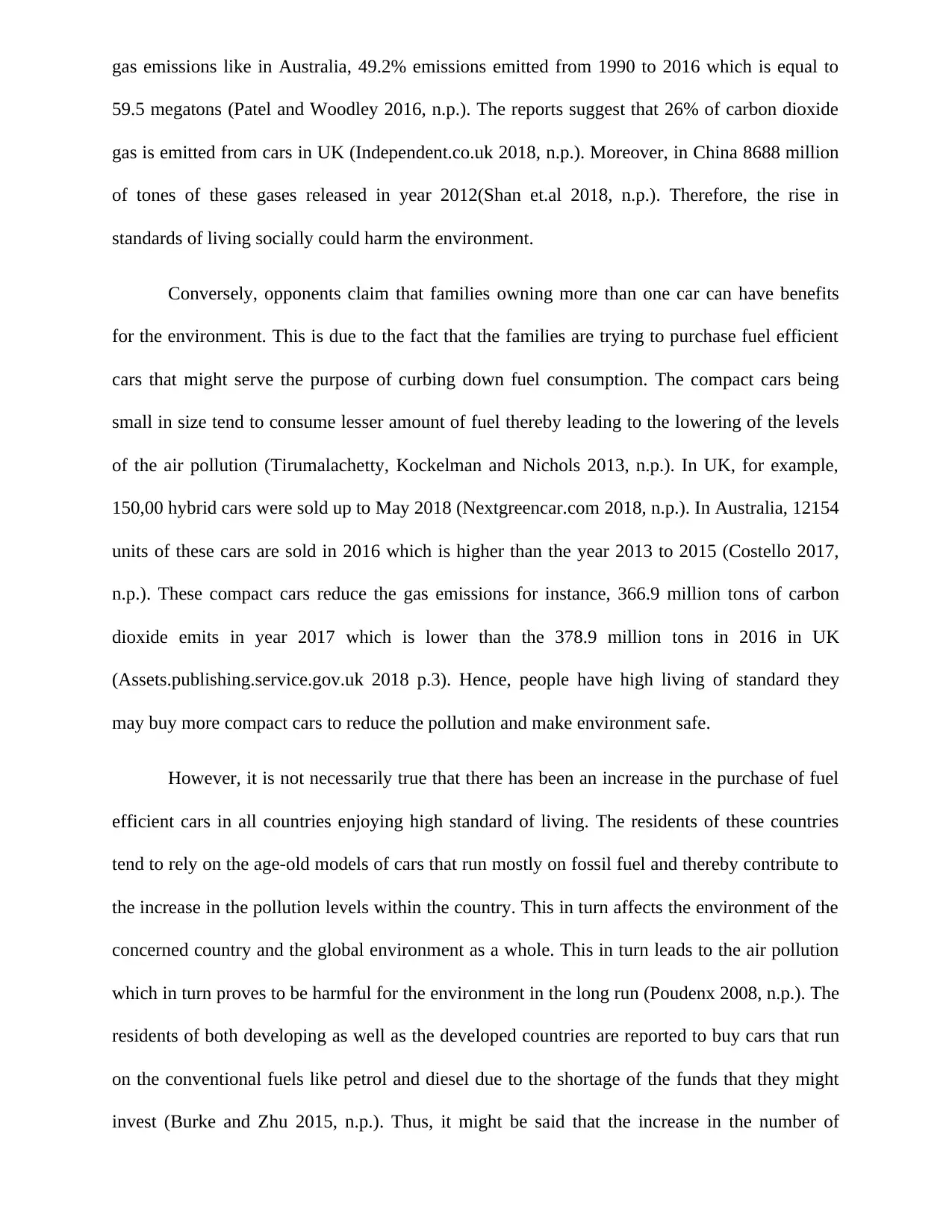
gas emissions like in Australia, 49.2% emissions emitted from 1990 to 2016 which is equal to
59.5 megatons (Patel and Woodley 2016, n.p.). The reports suggest that 26% of carbon dioxide
gas is emitted from cars in UK (Independent.co.uk 2018, n.p.). Moreover, in China 8688 million
of tones of these gases released in year 2012(Shan et.al 2018, n.p.). Therefore, the rise in
standards of living socially could harm the environment.
Conversely, opponents claim that families owning more than one car can have benefits
for the environment. This is due to the fact that the families are trying to purchase fuel efficient
cars that might serve the purpose of curbing down fuel consumption. The compact cars being
small in size tend to consume lesser amount of fuel thereby leading to the lowering of the levels
of the air pollution (Tirumalachetty, Kockelman and Nichols 2013, n.p.). In UK, for example,
150,00 hybrid cars were sold up to May 2018 (Nextgreencar.com 2018, n.p.). In Australia, 12154
units of these cars are sold in 2016 which is higher than the year 2013 to 2015 (Costello 2017,
n.p.). These compact cars reduce the gas emissions for instance, 366.9 million tons of carbon
dioxide emits in year 2017 which is lower than the 378.9 million tons in 2016 in UK
(Assets.publishing.service.gov.uk 2018 p.3). Hence, people have high living of standard they
may buy more compact cars to reduce the pollution and make environment safe.
However, it is not necessarily true that there has been an increase in the purchase of fuel
efficient cars in all countries enjoying high standard of living. The residents of these countries
tend to rely on the age-old models of cars that run mostly on fossil fuel and thereby contribute to
the increase in the pollution levels within the country. This in turn affects the environment of the
concerned country and the global environment as a whole. This in turn leads to the air pollution
which in turn proves to be harmful for the environment in the long run (Poudenx 2008, n.p.). The
residents of both developing as well as the developed countries are reported to buy cars that run
on the conventional fuels like petrol and diesel due to the shortage of the funds that they might
invest (Burke and Zhu 2015, n.p.). Thus, it might be said that the increase in the number of
59.5 megatons (Patel and Woodley 2016, n.p.). The reports suggest that 26% of carbon dioxide
gas is emitted from cars in UK (Independent.co.uk 2018, n.p.). Moreover, in China 8688 million
of tones of these gases released in year 2012(Shan et.al 2018, n.p.). Therefore, the rise in
standards of living socially could harm the environment.
Conversely, opponents claim that families owning more than one car can have benefits
for the environment. This is due to the fact that the families are trying to purchase fuel efficient
cars that might serve the purpose of curbing down fuel consumption. The compact cars being
small in size tend to consume lesser amount of fuel thereby leading to the lowering of the levels
of the air pollution (Tirumalachetty, Kockelman and Nichols 2013, n.p.). In UK, for example,
150,00 hybrid cars were sold up to May 2018 (Nextgreencar.com 2018, n.p.). In Australia, 12154
units of these cars are sold in 2016 which is higher than the year 2013 to 2015 (Costello 2017,
n.p.). These compact cars reduce the gas emissions for instance, 366.9 million tons of carbon
dioxide emits in year 2017 which is lower than the 378.9 million tons in 2016 in UK
(Assets.publishing.service.gov.uk 2018 p.3). Hence, people have high living of standard they
may buy more compact cars to reduce the pollution and make environment safe.
However, it is not necessarily true that there has been an increase in the purchase of fuel
efficient cars in all countries enjoying high standard of living. The residents of these countries
tend to rely on the age-old models of cars that run mostly on fossil fuel and thereby contribute to
the increase in the pollution levels within the country. This in turn affects the environment of the
concerned country and the global environment as a whole. This in turn leads to the air pollution
which in turn proves to be harmful for the environment in the long run (Poudenx 2008, n.p.). The
residents of both developing as well as the developed countries are reported to buy cars that run
on the conventional fuels like petrol and diesel due to the shortage of the funds that they might
invest (Burke and Zhu 2015, n.p.). Thus, it might be said that the increase in the number of
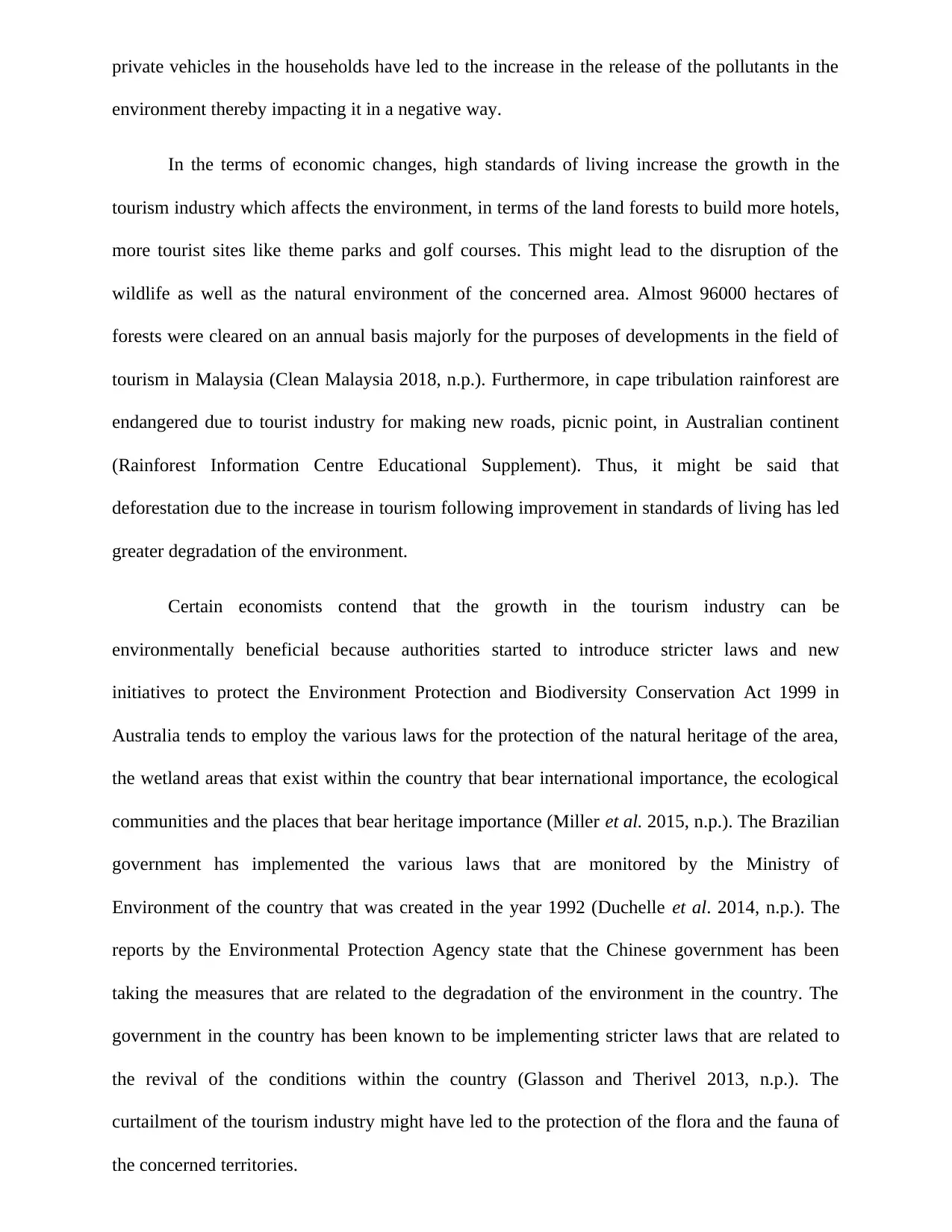
private vehicles in the households have led to the increase in the release of the pollutants in the
environment thereby impacting it in a negative way.
In the terms of economic changes, high standards of living increase the growth in the
tourism industry which affects the environment, in terms of the land forests to build more hotels,
more tourist sites like theme parks and golf courses. This might lead to the disruption of the
wildlife as well as the natural environment of the concerned area. Almost 96000 hectares of
forests were cleared on an annual basis majorly for the purposes of developments in the field of
tourism in Malaysia (Clean Malaysia 2018, n.p.). Furthermore, in cape tribulation rainforest are
endangered due to tourist industry for making new roads, picnic point, in Australian continent
(Rainforest Information Centre Educational Supplement). Thus, it might be said that
deforestation due to the increase in tourism following improvement in standards of living has led
greater degradation of the environment.
Certain economists contend that the growth in the tourism industry can be
environmentally beneficial because authorities started to introduce stricter laws and new
initiatives to protect the Environment Protection and Biodiversity Conservation Act 1999 in
Australia tends to employ the various laws for the protection of the natural heritage of the area,
the wetland areas that exist within the country that bear international importance, the ecological
communities and the places that bear heritage importance (Miller et al. 2015, n.p.). The Brazilian
government has implemented the various laws that are monitored by the Ministry of
Environment of the country that was created in the year 1992 (Duchelle et al. 2014, n.p.). The
reports by the Environmental Protection Agency state that the Chinese government has been
taking the measures that are related to the degradation of the environment in the country. The
government in the country has been known to be implementing stricter laws that are related to
the revival of the conditions within the country (Glasson and Therivel 2013, n.p.). The
curtailment of the tourism industry might have led to the protection of the flora and the fauna of
the concerned territories.
environment thereby impacting it in a negative way.
In the terms of economic changes, high standards of living increase the growth in the
tourism industry which affects the environment, in terms of the land forests to build more hotels,
more tourist sites like theme parks and golf courses. This might lead to the disruption of the
wildlife as well as the natural environment of the concerned area. Almost 96000 hectares of
forests were cleared on an annual basis majorly for the purposes of developments in the field of
tourism in Malaysia (Clean Malaysia 2018, n.p.). Furthermore, in cape tribulation rainforest are
endangered due to tourist industry for making new roads, picnic point, in Australian continent
(Rainforest Information Centre Educational Supplement). Thus, it might be said that
deforestation due to the increase in tourism following improvement in standards of living has led
greater degradation of the environment.
Certain economists contend that the growth in the tourism industry can be
environmentally beneficial because authorities started to introduce stricter laws and new
initiatives to protect the Environment Protection and Biodiversity Conservation Act 1999 in
Australia tends to employ the various laws for the protection of the natural heritage of the area,
the wetland areas that exist within the country that bear international importance, the ecological
communities and the places that bear heritage importance (Miller et al. 2015, n.p.). The Brazilian
government has implemented the various laws that are monitored by the Ministry of
Environment of the country that was created in the year 1992 (Duchelle et al. 2014, n.p.). The
reports by the Environmental Protection Agency state that the Chinese government has been
taking the measures that are related to the degradation of the environment in the country. The
government in the country has been known to be implementing stricter laws that are related to
the revival of the conditions within the country (Glasson and Therivel 2013, n.p.). The
curtailment of the tourism industry might have led to the protection of the flora and the fauna of
the concerned territories.
⊘ This is a preview!⊘
Do you want full access?
Subscribe today to unlock all pages.

Trusted by 1+ million students worldwide
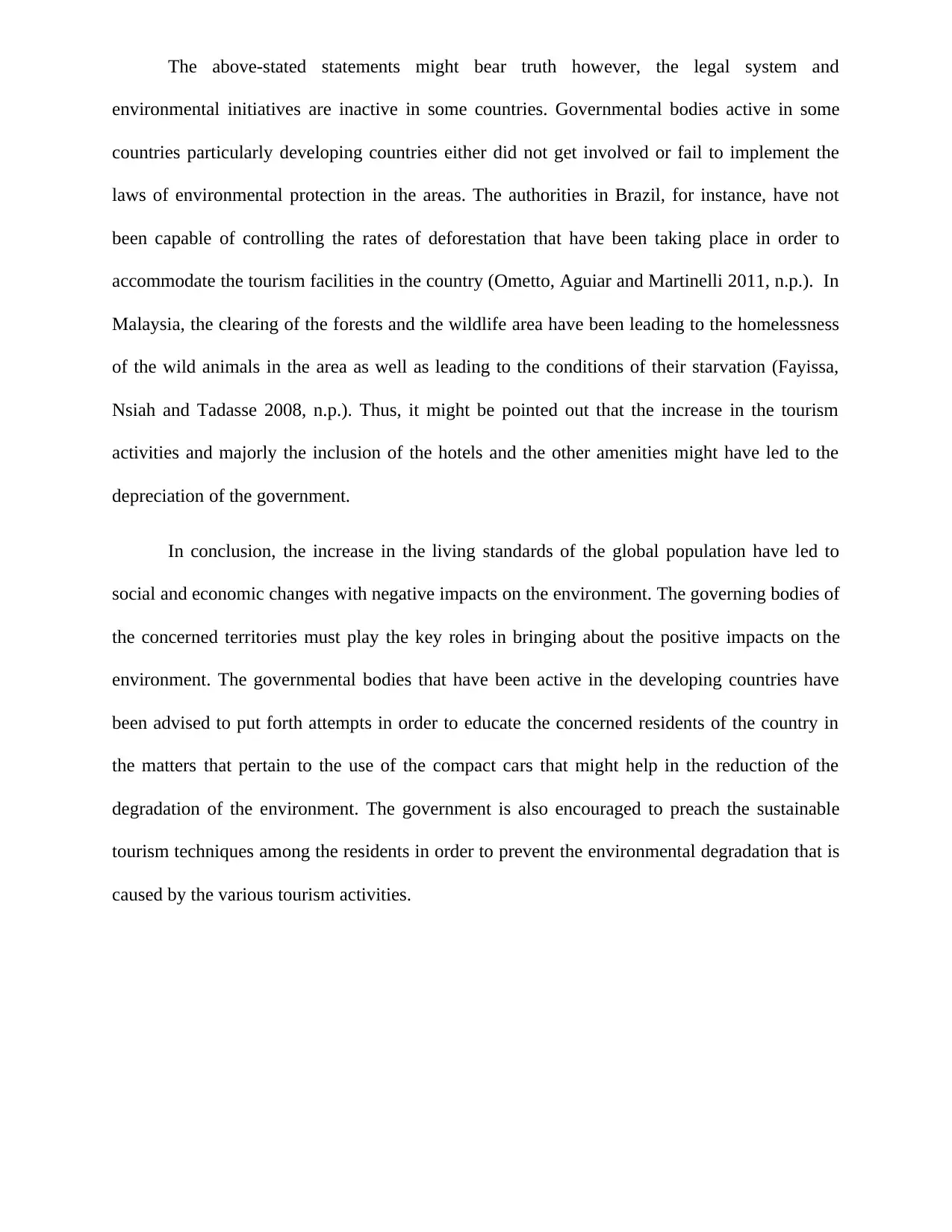
The above-stated statements might bear truth however, the legal system and
environmental initiatives are inactive in some countries. Governmental bodies active in some
countries particularly developing countries either did not get involved or fail to implement the
laws of environmental protection in the areas. The authorities in Brazil, for instance, have not
been capable of controlling the rates of deforestation that have been taking place in order to
accommodate the tourism facilities in the country (Ometto, Aguiar and Martinelli 2011, n.p.). In
Malaysia, the clearing of the forests and the wildlife area have been leading to the homelessness
of the wild animals in the area as well as leading to the conditions of their starvation (Fayissa,
Nsiah and Tadasse 2008, n.p.). Thus, it might be pointed out that the increase in the tourism
activities and majorly the inclusion of the hotels and the other amenities might have led to the
depreciation of the government.
In conclusion, the increase in the living standards of the global population have led to
social and economic changes with negative impacts on the environment. The governing bodies of
the concerned territories must play the key roles in bringing about the positive impacts on the
environment. The governmental bodies that have been active in the developing countries have
been advised to put forth attempts in order to educate the concerned residents of the country in
the matters that pertain to the use of the compact cars that might help in the reduction of the
degradation of the environment. The government is also encouraged to preach the sustainable
tourism techniques among the residents in order to prevent the environmental degradation that is
caused by the various tourism activities.
environmental initiatives are inactive in some countries. Governmental bodies active in some
countries particularly developing countries either did not get involved or fail to implement the
laws of environmental protection in the areas. The authorities in Brazil, for instance, have not
been capable of controlling the rates of deforestation that have been taking place in order to
accommodate the tourism facilities in the country (Ometto, Aguiar and Martinelli 2011, n.p.). In
Malaysia, the clearing of the forests and the wildlife area have been leading to the homelessness
of the wild animals in the area as well as leading to the conditions of their starvation (Fayissa,
Nsiah and Tadasse 2008, n.p.). Thus, it might be pointed out that the increase in the tourism
activities and majorly the inclusion of the hotels and the other amenities might have led to the
depreciation of the government.
In conclusion, the increase in the living standards of the global population have led to
social and economic changes with negative impacts on the environment. The governing bodies of
the concerned territories must play the key roles in bringing about the positive impacts on the
environment. The governmental bodies that have been active in the developing countries have
been advised to put forth attempts in order to educate the concerned residents of the country in
the matters that pertain to the use of the compact cars that might help in the reduction of the
degradation of the environment. The government is also encouraged to preach the sustainable
tourism techniques among the residents in order to prevent the environmental degradation that is
caused by the various tourism activities.
Paraphrase This Document
Need a fresh take? Get an instant paraphrase of this document with our AI Paraphraser
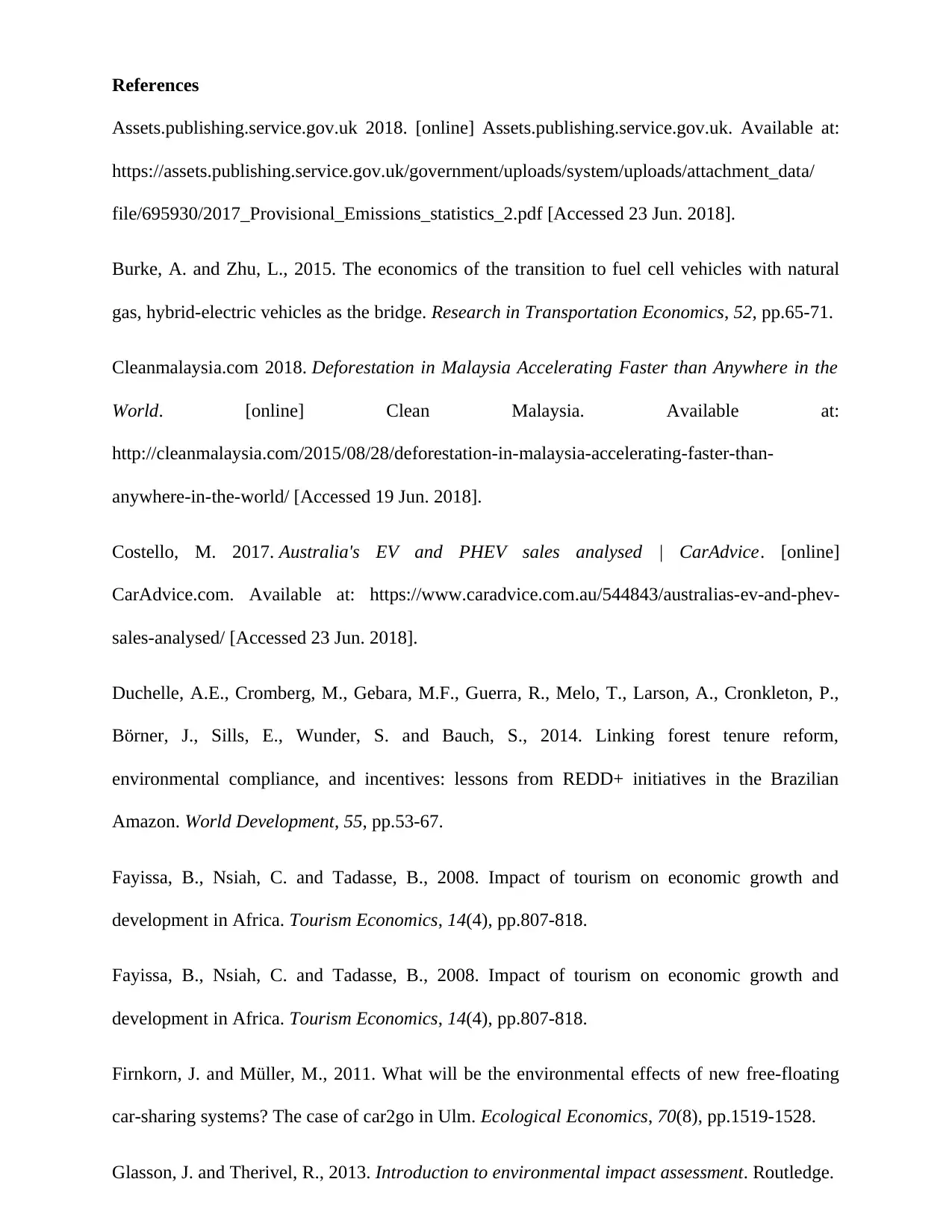
References
Assets.publishing.service.gov.uk 2018. [online] Assets.publishing.service.gov.uk. Available at:
https://assets.publishing.service.gov.uk/government/uploads/system/uploads/attachment_data/
file/695930/2017_Provisional_Emissions_statistics_2.pdf [Accessed 23 Jun. 2018].
Burke, A. and Zhu, L., 2015. The economics of the transition to fuel cell vehicles with natural
gas, hybrid-electric vehicles as the bridge. Research in Transportation Economics, 52, pp.65-71.
Cleanmalaysia.com 2018. Deforestation in Malaysia Accelerating Faster than Anywhere in the
World. [online] Clean Malaysia. Available at:
http://cleanmalaysia.com/2015/08/28/deforestation-in-malaysia-accelerating-faster-than-
anywhere-in-the-world/ [Accessed 19 Jun. 2018].
Costello, M. 2017. Australia's EV and PHEV sales analysed | CarAdvice. [online]
CarAdvice.com. Available at: https://www.caradvice.com.au/544843/australias-ev-and-phev-
sales-analysed/ [Accessed 23 Jun. 2018].
Duchelle, A.E., Cromberg, M., Gebara, M.F., Guerra, R., Melo, T., Larson, A., Cronkleton, P.,
Börner, J., Sills, E., Wunder, S. and Bauch, S., 2014. Linking forest tenure reform,
environmental compliance, and incentives: lessons from REDD+ initiatives in the Brazilian
Amazon. World Development, 55, pp.53-67.
Fayissa, B., Nsiah, C. and Tadasse, B., 2008. Impact of tourism on economic growth and
development in Africa. Tourism Economics, 14(4), pp.807-818.
Fayissa, B., Nsiah, C. and Tadasse, B., 2008. Impact of tourism on economic growth and
development in Africa. Tourism Economics, 14(4), pp.807-818.
Firnkorn, J. and Müller, M., 2011. What will be the environmental effects of new free-floating
car-sharing systems? The case of car2go in Ulm. Ecological Economics, 70(8), pp.1519-1528.
Glasson, J. and Therivel, R., 2013. Introduction to environmental impact assessment. Routledge.
Assets.publishing.service.gov.uk 2018. [online] Assets.publishing.service.gov.uk. Available at:
https://assets.publishing.service.gov.uk/government/uploads/system/uploads/attachment_data/
file/695930/2017_Provisional_Emissions_statistics_2.pdf [Accessed 23 Jun. 2018].
Burke, A. and Zhu, L., 2015. The economics of the transition to fuel cell vehicles with natural
gas, hybrid-electric vehicles as the bridge. Research in Transportation Economics, 52, pp.65-71.
Cleanmalaysia.com 2018. Deforestation in Malaysia Accelerating Faster than Anywhere in the
World. [online] Clean Malaysia. Available at:
http://cleanmalaysia.com/2015/08/28/deforestation-in-malaysia-accelerating-faster-than-
anywhere-in-the-world/ [Accessed 19 Jun. 2018].
Costello, M. 2017. Australia's EV and PHEV sales analysed | CarAdvice. [online]
CarAdvice.com. Available at: https://www.caradvice.com.au/544843/australias-ev-and-phev-
sales-analysed/ [Accessed 23 Jun. 2018].
Duchelle, A.E., Cromberg, M., Gebara, M.F., Guerra, R., Melo, T., Larson, A., Cronkleton, P.,
Börner, J., Sills, E., Wunder, S. and Bauch, S., 2014. Linking forest tenure reform,
environmental compliance, and incentives: lessons from REDD+ initiatives in the Brazilian
Amazon. World Development, 55, pp.53-67.
Fayissa, B., Nsiah, C. and Tadasse, B., 2008. Impact of tourism on economic growth and
development in Africa. Tourism Economics, 14(4), pp.807-818.
Fayissa, B., Nsiah, C. and Tadasse, B., 2008. Impact of tourism on economic growth and
development in Africa. Tourism Economics, 14(4), pp.807-818.
Firnkorn, J. and Müller, M., 2011. What will be the environmental effects of new free-floating
car-sharing systems? The case of car2go in Ulm. Ecological Economics, 70(8), pp.1519-1528.
Glasson, J. and Therivel, R., 2013. Introduction to environmental impact assessment. Routledge.
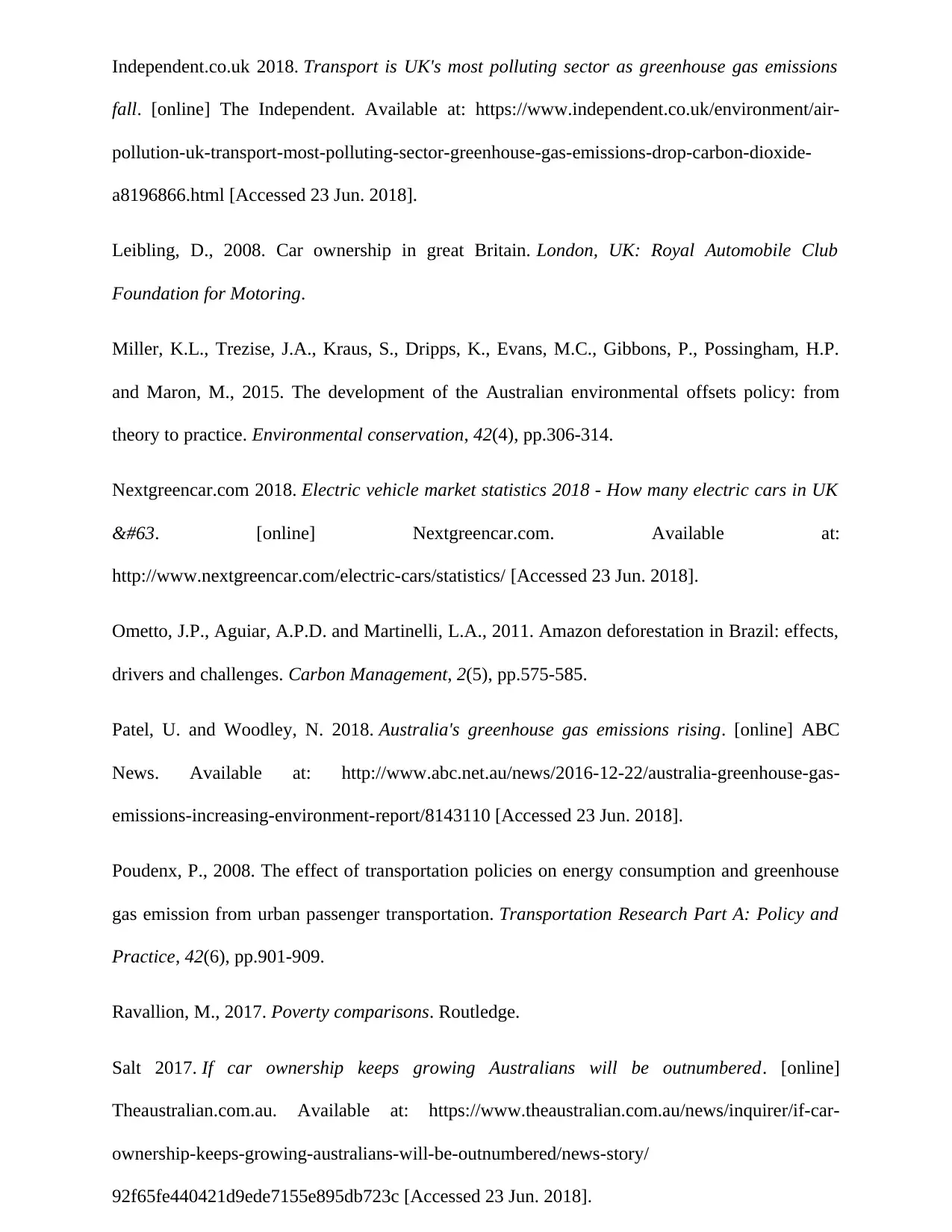
Independent.co.uk 2018. Transport is UK's most polluting sector as greenhouse gas emissions
fall. [online] The Independent. Available at: https://www.independent.co.uk/environment/air-
pollution-uk-transport-most-polluting-sector-greenhouse-gas-emissions-drop-carbon-dioxide-
a8196866.html [Accessed 23 Jun. 2018].
Leibling, D., 2008. Car ownership in great Britain. London, UK: Royal Automobile Club
Foundation for Motoring.
Miller, K.L., Trezise, J.A., Kraus, S., Dripps, K., Evans, M.C., Gibbons, P., Possingham, H.P.
and Maron, M., 2015. The development of the Australian environmental offsets policy: from
theory to practice. Environmental conservation, 42(4), pp.306-314.
Nextgreencar.com 2018. Electric vehicle market statistics 2018 - How many electric cars in UK
?. [online] Nextgreencar.com. Available at:
http://www.nextgreencar.com/electric-cars/statistics/ [Accessed 23 Jun. 2018].
Ometto, J.P., Aguiar, A.P.D. and Martinelli, L.A., 2011. Amazon deforestation in Brazil: effects,
drivers and challenges. Carbon Management, 2(5), pp.575-585.
Patel, U. and Woodley, N. 2018. Australia's greenhouse gas emissions rising. [online] ABC
News. Available at: http://www.abc.net.au/news/2016-12-22/australia-greenhouse-gas-
emissions-increasing-environment-report/8143110 [Accessed 23 Jun. 2018].
Poudenx, P., 2008. The effect of transportation policies on energy consumption and greenhouse
gas emission from urban passenger transportation. Transportation Research Part A: Policy and
Practice, 42(6), pp.901-909.
Ravallion, M., 2017. Poverty comparisons. Routledge.
Salt 2017. If car ownership keeps growing Australians will be outnumbered. [online]
Theaustralian.com.au. Available at: https://www.theaustralian.com.au/news/inquirer/if-car-
ownership-keeps-growing-australians-will-be-outnumbered/news-story/
92f65fe440421d9ede7155e895db723c [Accessed 23 Jun. 2018].
fall. [online] The Independent. Available at: https://www.independent.co.uk/environment/air-
pollution-uk-transport-most-polluting-sector-greenhouse-gas-emissions-drop-carbon-dioxide-
a8196866.html [Accessed 23 Jun. 2018].
Leibling, D., 2008. Car ownership in great Britain. London, UK: Royal Automobile Club
Foundation for Motoring.
Miller, K.L., Trezise, J.A., Kraus, S., Dripps, K., Evans, M.C., Gibbons, P., Possingham, H.P.
and Maron, M., 2015. The development of the Australian environmental offsets policy: from
theory to practice. Environmental conservation, 42(4), pp.306-314.
Nextgreencar.com 2018. Electric vehicle market statistics 2018 - How many electric cars in UK
?. [online] Nextgreencar.com. Available at:
http://www.nextgreencar.com/electric-cars/statistics/ [Accessed 23 Jun. 2018].
Ometto, J.P., Aguiar, A.P.D. and Martinelli, L.A., 2011. Amazon deforestation in Brazil: effects,
drivers and challenges. Carbon Management, 2(5), pp.575-585.
Patel, U. and Woodley, N. 2018. Australia's greenhouse gas emissions rising. [online] ABC
News. Available at: http://www.abc.net.au/news/2016-12-22/australia-greenhouse-gas-
emissions-increasing-environment-report/8143110 [Accessed 23 Jun. 2018].
Poudenx, P., 2008. The effect of transportation policies on energy consumption and greenhouse
gas emission from urban passenger transportation. Transportation Research Part A: Policy and
Practice, 42(6), pp.901-909.
Ravallion, M., 2017. Poverty comparisons. Routledge.
Salt 2017. If car ownership keeps growing Australians will be outnumbered. [online]
Theaustralian.com.au. Available at: https://www.theaustralian.com.au/news/inquirer/if-car-
ownership-keeps-growing-australians-will-be-outnumbered/news-story/
92f65fe440421d9ede7155e895db723c [Accessed 23 Jun. 2018].
⊘ This is a preview!⊘
Do you want full access?
Subscribe today to unlock all pages.

Trusted by 1+ million students worldwide
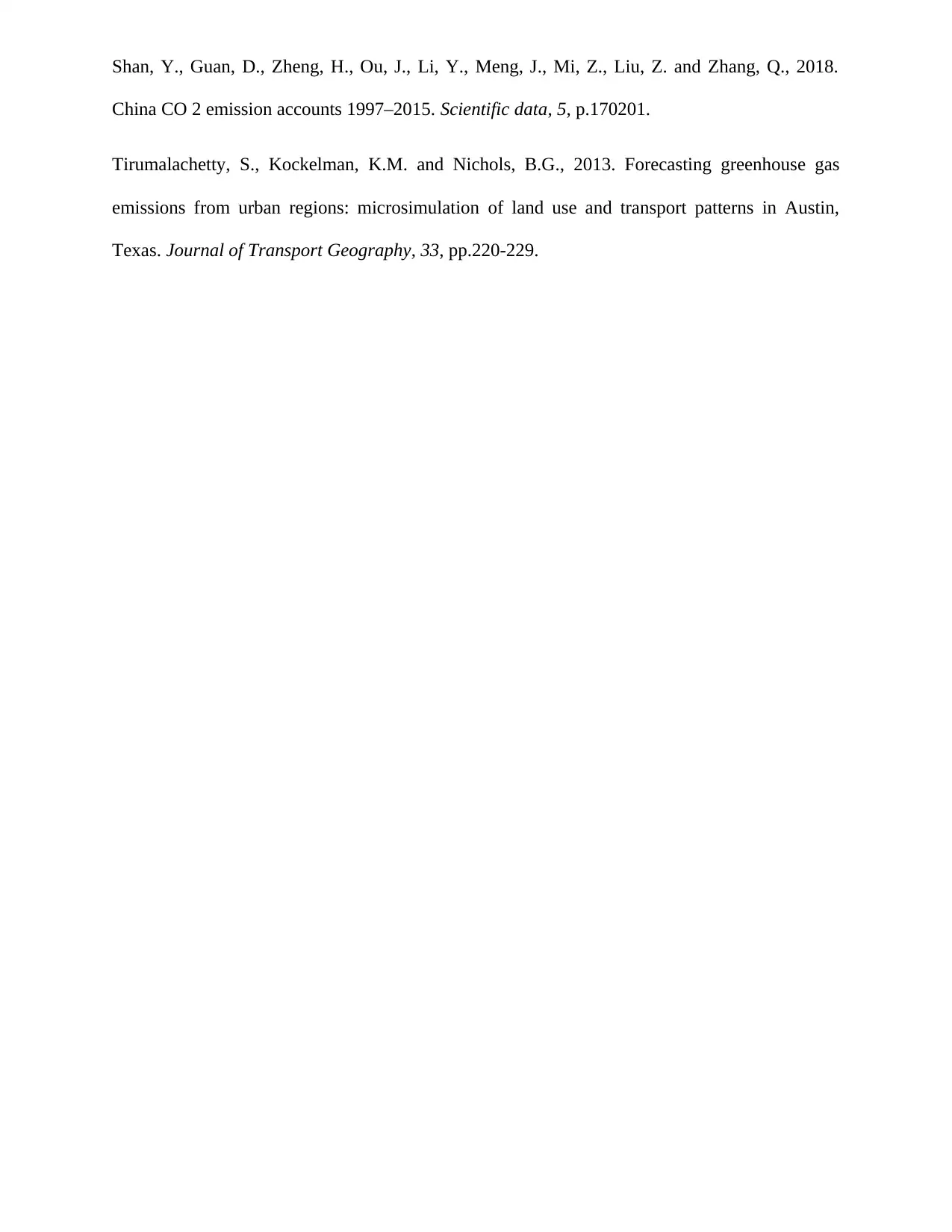
Shan, Y., Guan, D., Zheng, H., Ou, J., Li, Y., Meng, J., Mi, Z., Liu, Z. and Zhang, Q., 2018.
China CO 2 emission accounts 1997–2015. Scientific data, 5, p.170201.
Tirumalachetty, S., Kockelman, K.M. and Nichols, B.G., 2013. Forecasting greenhouse gas
emissions from urban regions: microsimulation of land use and transport patterns in Austin,
Texas. Journal of Transport Geography, 33, pp.220-229.
China CO 2 emission accounts 1997–2015. Scientific data, 5, p.170201.
Tirumalachetty, S., Kockelman, K.M. and Nichols, B.G., 2013. Forecasting greenhouse gas
emissions from urban regions: microsimulation of land use and transport patterns in Austin,
Texas. Journal of Transport Geography, 33, pp.220-229.
1 out of 7
Related Documents
Your All-in-One AI-Powered Toolkit for Academic Success.
+13062052269
info@desklib.com
Available 24*7 on WhatsApp / Email
![[object Object]](/_next/static/media/star-bottom.7253800d.svg)
Unlock your academic potential
Copyright © 2020–2025 A2Z Services. All Rights Reserved. Developed and managed by ZUCOL.





